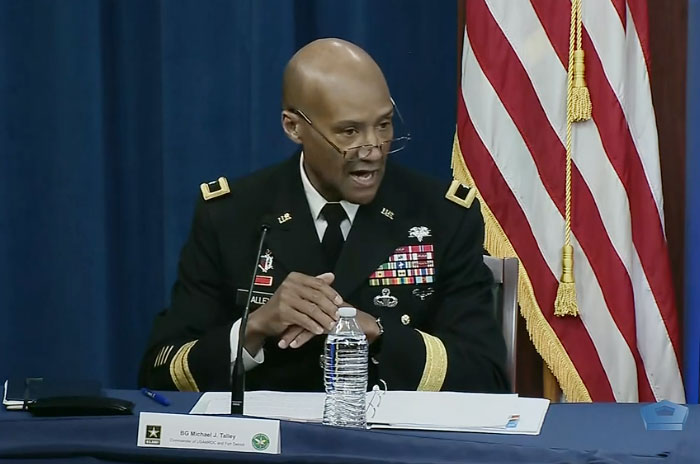USAMRDC Moving Quickly on Coronavirus Response, Vaccine

In a news conference on U.S. military efforts to track and treat the global rash of novel coronavirus (COVID-19) cases, the U.S. Army Medical Research and Development Command's (USAMRDC) Brigadier General Michael J. Talley offered a calm, reassuring statement.
"We are supporting a whole-of-government approach to detect, prevent, and treat COVID-19," said Talley, speaking to news media from The Pentagon in Arlington, Virginia, on March 5. "We are progressing at very fast rates – at revolutionary rates almost."
Flanked by a trio of USAMRDC scientists who offered perspective from all levels of the COVID-19 response effort, Talley stated the USAMRDC is exploring both treatment and vaccine options for the virus, while noting that additional vaccine options are being developed by other federal organizations. Talley further highlighted the USAMRDC's enduring commitment to the U.S. Soldier as the main driver in the response effort, while additionally pointing to the Command's unique expertise in handling previous, similar types of public health concerns, such as the Command's work in combatting both Severe Acute Respiratory Syndrome (SARS) and Middle East Respiratory Syndrome (MERS); both of which reside in the same family of coronaviruses as COVID-19.
Said Talley, "When it comes to infectious disease threats, we have extensive capabilities and an international research infrastructure already in place that allows our scientists to anticipate and develop countermeasures against emerging infectious diseases."
Talley was joined at the news conference by Col. Wendy Sammons Jackson, Director of the USAMRDC Military Infectious Diseases Research Program; Dr. Nelson Michael, Director, Center for Infectious Disease Research at the Walter Reed Army Institute of Research (WRAIR); and Dr. Kayvon Modjarrad, Director for Emerging Infectious Diseases at WRAIR. Modjarrad offered the most granular description of the DOD effort to develop a COVID-19 vaccine; an effort which focuses almost exclusively on the tiny spoke-like attachments – or, in clinical terms, the "spike proteins" – that expand outward from the virus itself.
"If you block that attachment," said Modjarrad, "if you give a vaccine that trains and educates your immune system to recognize that part of the virus that attaches to your cells and blocks it, that's going to be a good vaccine."
Modjarrad further stated the response teams are working in coordination with interagency partners at the Vaccine Research Center at the National Institutes of Health (NIH); with whom they are in constant communication. Further, according to Modjarrad, scientists have already begun testing preliminary vaccines.
In addition to those developments, USAMRDC officials noted that members of the general public can take a proactive stance in the grassroots level of the response effort.
"If there's one thing you can do more than any other, it's wash your hands," said Michael, who further pointed out the USAMRDC and its corporate partners hope to boost testing output for the virus in the next few months; with those projections based on WRAIR's extensive HIV research models.
During comments on advanced development efforts surrounding COVID-19, Sammons-Jackson confirmed that samples of the virus itself were received by U.S. Army Medical Research Institute of Infectious Diseases (USAMRIID) at Fort Detrick, Maryland, and that scientists are growing and culturing the virus in order to create a stock for future research efforts.
Said Talley in a final comment on the commitment to COVID-19 response, "We're all working towards a solution, and we want to get it done as quickly as possible."














